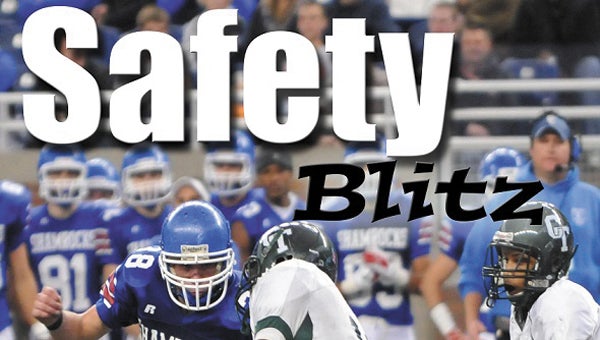Part 2: Safety first for the MHSAA
Published 8:44 am Tuesday, November 19, 2013
 With so much publicity concerning football safety, the football group was a natural to become the first of several task forces to be assembled.
With so much publicity concerning football safety, the football group was a natural to become the first of several task forces to be assembled.
“We must educate the public on the benefits of all school sports,” said task force member Bill Chilman, superintendent of Beal City Schools. “In the case of football, it must be impressed upon people that it is statistically a very safe game when taught and played properly. The Football Task Force being proactive rather than reactive to this safety movement is key to promoting the lifelong values of football and all school sports.”
And within that public is a group which has the most vested concerns: the parents.
“There is more information available to the general public regarding sport and sport injuries, and unfortunately parents and kids all too often hear about the negative side of sport,” suggests Mike Bakker, athletic director at Fenton High School, and another member of the MHSAA Football Task Force. “It is imperative for the integrity of the sport of football to have coaches and administrators provide information about the safety of the game and the steps we take to keep kids safe. We must educate parents about the proper way to play the game and the signs to look for if problems arise.”
Without getting into the minutia of the new NCAA and NFL playing rules regarding use of the helmet, suffice it to say this will be an interesting fall during which to monitor penalties and their effects on injury numbers, particularly when it comes to concussions.
The rules changes have been reported and debated at the national level ad nauseam, and the mood seems to inexplicably tilt toward skepticism and criticism from the very group that would stage a revolt of epic proportions if football ever became extinct: the fans.
Case in point: six targeting fouls were called in 75 games during the opening weekend of college football over Labor Day Weekend (one ejection was overturned by replay), and the outcry began. Analysts and fans are afforded frame-by-frame replays which onfield officials do not have the luxury of seeing before throwing the flag.
Like it or not, the rules are in place. And, they have been implemented to protect the future of the game. The impetus now falls to the caretakers of the game – the officials – who no doubt will bear the brunt of disapproving masses in the stadiums. Yet, football is their livelihood too; both players and officials are expected to make adjustments.
At Officiate Michigan Day and the ensuing National Association of Sports Officials Summit this past July in Grand Rapids, the theme was clear: “The game has changed, and the officiating has to change with it.”
From NFL Referee Jeff Triplette to SEC Coordinator of Officials Scott Shaw to Big Ten Referee Alex Kemp and Fox Sports NFL Rules Analyst Mike Pereira – people who have been around the block – the message delivered was that the changes are necessary for the health and growth of football.
“We’re talking about taking out a specific type of play that, quite honestly, you didn’t see that much of before about 10 years ago,” Triplette said during a player safety panel at the NASO Summit. “They still played defense, there were still great hits. But somehow, these violent types of tackles began to get notoriety – whether it was all the ESPN highlights, YouTube, and maybe a combination of all of that stuff – and players started to celebrate those hits, and that became the goal.”
Not only can the game become safer; it might even become better by going retro. In recent comments on The Sports XChange, NFL analyst and former coach John Madden said, “You are always concerned how any change will impact the game. In this case, players are not going for the head shot, that big hit. They are keeping their heads up. Better tackling has become the unintended consequence. That’s a good thing. Good for football. Good for kids watching. Players are tackling the way they are supposed to, with their shoulders and wrapping up. The big hit, the big replay had become so popular that tackling suffered.”
In high school, the most notable rule change involving helmets involves penalties for players who lose their helmets during a play. However, illegal helmet contact continues to be a point of emphasis and carries a minimum of a 15-yeard penalty as it has for many years. In the NCAA the mantra on helmet-to-helmet blows is, “When in doubt throw them out,” as the foul now carries with it a player ejection.
That is not the high school rule—yet—but officials at all levels need to be on the lookout. Kemp was quick to warn a roomful of prep football officials during Officiate Michigan Day, “We’ve been told to err on the side of safety, and these plays will result in ejection,” while also adding that such plays will be reviewed by replay officials. “That portion of the rule isn’t there in high school yet, but be ready for it; it’s coming, so when it happens in your games take notice and determine the severity.”
Which brings us to contest rules for safer play. During the next few years, various sport groups will be assembled to follow the MHSAA football task force’s lead in scrutinizing rules and developing proposals for revisions or additions to be submitted to the National Federation of State High School Associations. Initial football discussions receiving some traction involve changing the enforcement spot on post-interception penalties and limiting the number of yards teams can run up on free kicks. Before any submissions are made to the NFHS Football Committee, the task force will conduct research and present findings to Michigan committees.
“We can make changes ourselves – through MHSAA sport committees – for the subvarsity level, but our committees can only make recommendations to national rules committees for varsity level play,” explained Roberts. “Over the next four years, we will be asking our sport committees to give more time to the most dangerous plays in their sport – identifying what they are and proposing how to reduce that danger.”
While the football task force here at home is finalizing practice policy proposals targeted for implementation in the fall of 2014, Texas and Illinois are two states which launched restrictions with the opening of football this season. Spokespersons from both states indicate that coaches and school administrators have been pleased with the new formats.
Coaches no doubt will need to adjust practice itineraries and budget time wisely. Administrators need to remind staffs that the new era is dawning in the name of player safety, which is paramount to all parties.
“In game situations, coaches want our officials to throw the flag on late hits, low hits and other illegal contact,” Roberts said. “These are incidents that they have no control over. They do have control over practice time and teaching fundamentals; so let’s encourage safety measures that we can control, and employ those tactics to help the game prosper.”
Education will key the efforts to align coaches of all sports – and all levels – in the movement toward a healthy future. School will be in session during the next four years as the MHSAA implements effective and practical means for raising coaches’ preparedness. Three avenues are on the map:
First, the Representative Council mandated that beginning with the 2014-15 school year, all assistant and subvarsity coaches at the high school level must complete the same MHSAA rules meetings currently only required of varsity head coaches or, alternatively, one of the free online sports safety courses posted on or linked from the MHSAA Website that is designated as fulfilling this requirement.
Second, it is proposed that by 2015-16, MHSAA member high schools will be required to certify that all of their varsity head coaches have a valid CPR certification.
Third, it is proposed that by 2016-17, any person who is hired for the first time to be the varsity head coach of a high school team, to begin after July 31, 2016, must have completed either Level 1 or Level 2 of the MHSAA Coaches Advancement Program. The MHSAA is preparing to subsidize some of the course cost for every coach who completes Level 1 or 2.
Together, these changes will move Michigan from one of the states of fewest coaching requirements to a position consistent with the “best practices” for minimizing risk in school sports and providing students a healthy experience.
At stake in these four thrusts – whether for an administrator, coach, official, student-athlete, parent or fan – are the environments that offer so many lessons and the games for which we root.





